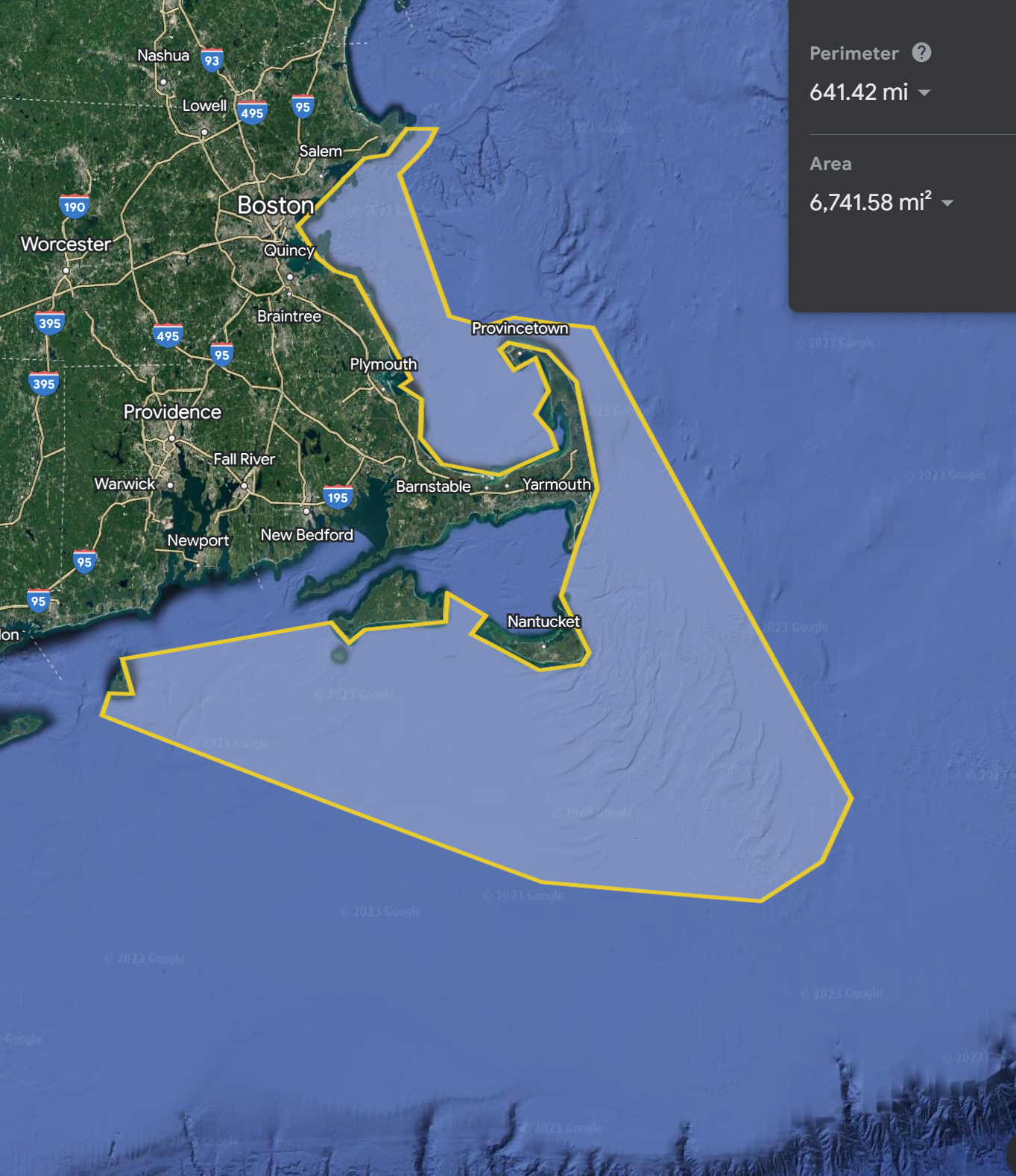What If There Was a Right Whale Marine Sanctuary in R.I./Mass. Waters?
November 6, 2023
The North Atlantic right whale is a critically endangered whale. In the 1970s, with the first whale watches, there were estimated to be 350 right whales, and the population was growing. Then, in 2017, right whales took a turn for the worse. By 2020, the population had fallen to 338 right whales, with only 50-70 breeding females. We must now do more to protect and restore these whales.
Stellwagen Bank Sanctuary
In 1992, when there were about 370 right whales, the Stellwagen Bank National Marine Sanctuary was established under the auspices of the National Oceanic and Atmospheric Administration (NOAA). The first order of business was to establish its advisory council with selected individuals to represent conservation, education, research, recreational and commercial fishing, diving, whale watching, business, maritime heritage, and a youth seat. The council also included representatives from the sanctuary’s government partners, including the Coast Guard, the New England Fishery Management Council, NOAA’s National Marine Fisheries Service, and Massachusetts state agencies.
To protect whales in the Sanctuary, an agreement was made with the Coast Guard to increase air and sea patrols. Cooperative work with the National Marine Fisheries Service, conservation organizations, and the whale watching industry led to the development of a set of whale watching guidelines for the Northeast.
Whale disentanglement network
The Sanctuary established an emergency whale disentanglement network with the Center for Coastal Studies and other partners. To avoid entanglements, a Sanctuary researcher developed breakaway lobster trap lines that sank between pots.
Working with the Coast Guard and the International Maritime Organization, a mandatory ship reporting system (MSRS) was implemented in July 1999. All ships traveling through North Atlantic right whale habitat, including the Sanctuary, were required to report their location, course, speed, and destination. In return, they received automated messages containing more specific information about whale sightings in the area and precautionary tactics, such as changing course and speed, to avoid contact or collision with whales.
Ship collision avoidance system
At the Sanctuary’s urging, the Coast Guard developed a ship collision avoidance system called the Automatic Identification System (AIS). All ships over 300 gross tons were required to carry an AIS transponder and broadcast the ship’s position, course, and heading, as well as the ship’s particulars and cargo. This data was used to better understand ship traffic patterns and speeds concerning the distribution and abundance of whales to reduce collisions.
Sanctuary scientists worked with whale research organizations to compile 25 years of whale watching data. Stellwagen Bank is a rectangular threshold, running north to south, between Massachusetts Bay and the Gulf of Maine. Surprisingly, whale sightings were not uniform across the bank but instead were shaped more like a figure eight. Northwest ship traffic to Boston bisected the lower portion of the high-density whale area. Here was the greatest risk for deadly ship strikes of whales.
Changes to the shipping lane, whale alert app
By working closely with the shipping industry and other partners in NOAA, the Sanctuary proposed moving the shipping channel 12 degrees east to cross the bank in a shorter distance where whales were less abundant, thus protecting whales from getting struck by ships. Approved in 2007, adjusting the shipping lane resulted in a 58% reduction in the risk of ship strikes for right whales and an 81% reduction for all baleen whales.
In 2008, in response to the proposed installation in Boston of two of the nation’s first offshore deepwater liquid natural gas (LNG) ports, the two LNG companies were required to install the world’s first automatic whale detection system. Ten “listening buoys” were located along the shipping channel into Boston. Sounds picked up by the buoys were recorded and sent to Cornell’s Ornithology Laboratory to identify and confirm the presence of whales. A message was sent back to activate a 10-knot slow speed zone around the buoy, and a notice was sent to LNG ships to slow down.
Seasonal slow speed zones in the presence of North Atlantic right whales were set up by NOAA offshore of major East Coast ports from the whale breeding ground off Jacksonville, Fla., north to Boston. Sanctuary researchers used the AIS to analyze the tracks and speeds of all vessels and sent annual report cards to the companies.
In 2012, the Whale Alert app provided a clearinghouse of information for mariners on the location of whales. The listening buoys documented the return of some right whales to Massachusetts as early as January of that year.
Increasing right whale population
By 2013, the North Atlantic right whale population had risen to 476. With an increasing population, some right whales left the Gulf of Maine for the larger Gulf of St. Lawrence. Right whale numbers went down when researchers reported fewer whales in their usual seasonal haunts until 2015 and 2016, when 40 to 45 right whales were found north of Nova Scotia and New Brunswick. Researchers have identified individual right whales based on patterns of bristled facial hair and callused skin called callosities. Examining photographs of the two sets of whales observed in Canadian waters during the two summers, researchers identified 74 individual whales. It is unknown whether different right whales came during different summers or if the survey area was too small to include all of the whales in one summer. What is known is that it’s very difficult to count whales in the rollicking sea.

In 2017, 100 North Atlantic right whales were counted in the Gulf of St. Lawrence. This might not have meant more right whales because efforts and the search area nearly doubled. That summer, I boarded a sailing ship in Corner Brook, Newfoundland, where locals were thrilled to see two right whales feeding in the Bay of Islands. I doubt these whales were counted, as they were outside the survey area.
Unusual Mortality Event
We anchored for the night near the mouth of the bay in Lark Harbor. At sunset, a rainbow rose over the table-topped mountain. The next morning, clearing away from Newfoundland, a shipmate from Corner Brook told me a dead right whale had been found in Bottle Cove, which is on the outer side of the peninsula less than 2 miles west of Lark Harbor. Photos of the whale carcass revealed what looked like a gray 40-fott drysuit tossed across the rocks. It was only skin and blubber, empty of bones and internal organs. This whale had been examined many weeks earlier, floating dead on the other side of the Gulf of St. Lawrence, and had died of a ship strike off the coast of New Brunswick.
Twelve right whales were found dead by ship strikes and entanglements in the Gulf of St. Lawrence that summer of 2017. One right whale calf had been found dead in Cape Cod Bay the previous April. NOAA proclaimed 2017 as an unusual mortality event, and unfortunately, the tragic event is ongoing. The whale population is falling. Today, only about 350 right whales remain.
We have been increasing our use of these nutrient-rich waters. Right whales are harmed by increased ship traffic, pollution including herbicides (glyphosate) from the land that bioaccumulate up the food web, shifting currents, and warming waters. In the Gulf of Maine, phytoplankton, plants at the foundation of ocean food webs, are 65% less productive than 20 years ago. These ocean waters are impacted by climate change. Our systemic challenges have become more complex, and the corresponding solutions must be adaptive and more robust.
Solution: A new MA/RI Right Whale National Marine Sanctuary
It is time for community groups, interests, and organizations to call for a MA/RI North Atlantic Right Whale National Marine Sanctuary to protect these animals and their critical marine habitat. This can be done through education, research, and resource protection efforts informed by an active advisory council. The Sanctuary would work with community and interest groups, including conservationists, scientists, fishers, wind turbine and boat operators, government agencies, and others. Named positions on the Advisory Council would include Narraganset and Wampanoag Aquinna representatives in an effort to partner with Indigenous knowledge holders.
Adjacent to and south of Stellwagen Bank National Marine Sanctuary (842 square miles), the new right whale sanctuary might be 7,000 square miles, including Cape Cod Bay, around the outer Cape across Nantucket Shoals to Block Island. The boundary may be 640 miles, including 275 miles of coastal Massachusetts and Block Island.
To restore the North Atlantic right whale population, quarterly meetings of the Sanctuary’s Advisory Council would advance the work of the Sanctuary to develop comprehensive interagency plans and increase data sharing between academia, government, industry, and community groups. The objectives are to maximize the available data and increase the analytical rigor to develop and implement directed studies of right whale population-level changes. The Sanctuary works closely with local, state, and government agencies to continue implementing improvements for right whales.
The lesson of the Stellwagen Bank National Marine Sanctuary is that right whales benefited, and the population grew when diverse interests collaborated at all levels of government. But Stellwagen is north of the sandy shoaling waters that hungry right whales rely on to break their winter fast. Working in concert with others, a MA/RI North Atlantic Right Whale National Marine Sanctuary would protect and restore right whale populations.
Rob Moir is president and executive director of Cambridge, Mass.-based Ocean River Institute, a nonprofit providing support for the efforts of environmental organizations.




The southern portion of the domain you propose is presently under active development for offshore wind. Can that be consistent with a Marine Sanctuary?
Would the sanctuary bar fishing and boat traffic, the number one and two killers of right whales, or would it just bar wind farms?
If we were serious about saving the Right Whale this would be done. But instead we are turning the Ocean State into the Turbine State.